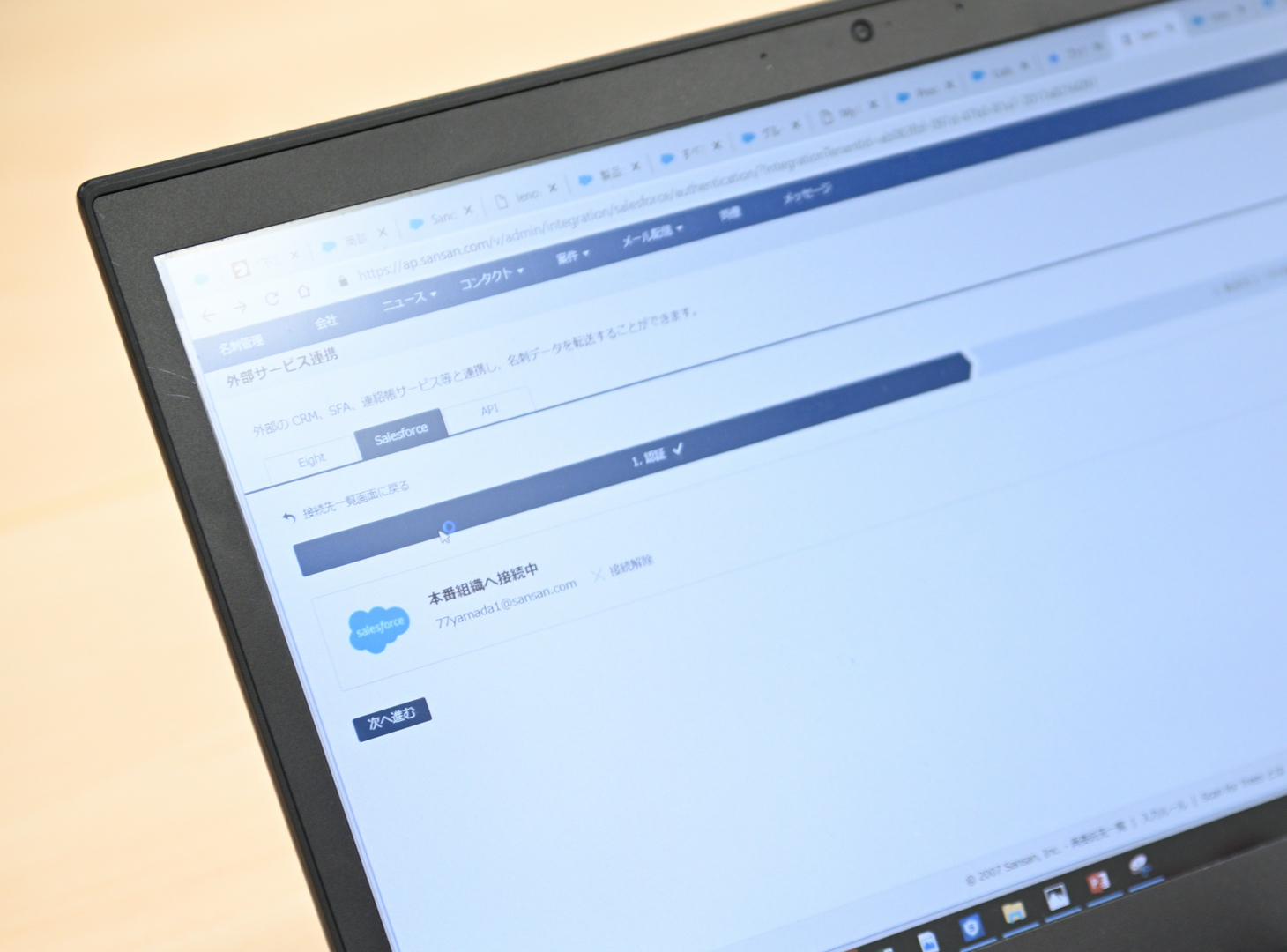The Commercial Sales Operations Division handles companywide sales support, and Mr. Tsuru’s role focuses on implementing and managing in-house use of systems such as Sansan and Salesforce. Since starting at Lenovo Japan in corporate PC sales, Mr. Tsuru has worked in operations and in payroll management, making him one of the most experienced senior members in the whole firm.

In 2005, Lenovo acquired a PC business to make it one of the largest computer manufacturers worldwide by volume. In 2008, it introduced a global initiative to adopt a CRM system, but the lack of effort in the implementation meant most of the sales teams continued to manage their customer data in Excel.
On top of that, it was hard to keep a centralized CRM database with team members constantly changing and the system constantly being updated. This resulted in further scattering of information throughout the company. Our ongoing struggle with effectively managing our clients’ data and making revenue projections was setting us back, and in 2012 we turned to Salesforce to give us solutions. I was put in charge of managing the successful implementation of Salesforce, by supporting the users and measuring and encouraging its adoption.
Having tried many different approaches and customizations, we got to a point where we could manage our contact lists, but the fundamental problem hadn’t been resolved: users weren’t inputting customer data into the system. The incomplete database meant it wasn’t functioning as a CRM that we could in fact use.
It was then that a newly hired server sales staff suggested we use Sansan. Joining a company and grasping how much resources the company and each staff have takes a long time. Sansan could help solve this problem by giving them the access to the existing contact data. We found many of our sales staff wanted this information to be shared between teams selling different products.
The sales team went directly to the CEO to propose we use Sansan, and it was quickly given the green light. This was because the CEO had been an Eight user and had a rough idea of how Sansan might work. Also, as Sansan was getting ready to launch a function to integrate with Salesforce, we felt it could be the answer to our longstanding challenge of utilizing Salesforce to the fullest. It looked like it might be able to kill two birds with one stone. We signed up 300 staff for a 3-month trial to check the usability.
To test the accuracy of digitization and whether the sales teams could truly utilize the cloud database, we asked our staff to provide all the business cards they owned, and scanned them into Sansan.

To begin with, it took a few days to scan and digitize the mountain of cards we had. But we found out with time that the scanned data was appearing in the database by the following day. With digitization accuracy close to 100%, and hearing how easy it was to use and how convenient it was to access it on the go, we decided to sign up for full membership.
My concern at the time was whether I could manage to get Sansan and Salesforce to integrate. I’d expected it to require some expert knowledge of building systems. But with some assistance from the online manual and the help team, I managed to set it up without any issues. After completing the settings, Sansan’s client data were transferred into Salesforce in a matter of hours. It was then that I realized how tremendously valuable Sansan would be for us.


Getting in the habit of using new services isn’t that easy. This is why I decided to focus purely on asking staff to scan in as many cards as possible and kept from telling them about the other useful functions. Despite my tactical efforts, it was still hard to get them all on board.
This led me to think that some type of enforcement is needed for more successful adoption.
The first approach was to send out a monthly email announcing the ranking of the number of scanned cards, to the CEO, head of the finance division, directors in the sales division, and all sales staff. I sent a message that it’s in the company’s best interests to utilize Sansan to turn business cards into priceless company assets.
The other approach, which a colleague offered, was to make it a requirement to include all team members’ progress on scanning cards in the agenda of the weekly sales meetings, which allowed the teams to discuss how much scanning was being done. This was effective in driving up the percentage of users using the scan function from the initial 50% to 90% today.
Now that the clients’ contact information was automatically reflected into Salesforce through Sansan, there was no longer time wasted on inputting the data by hand. Also, as data are saved and accumulate in the system, when a sales rep takes over ownership of a client account, the new rep can access the client database. This makes handoff very efficient. For these reasons, since introducing Sansan we’ve seen a tenfold increase in the number of key contacts added into Salesforce.
The integration with Sansan meant duplicated contacts were being created in Salesforce, but we were able to minimize it by following the rules set by Sansan and Salesforce on registering contacts. We knew about this before signing up, but the fact that it ensured the contacts to be added onto Salesforce was more than enough reason, and we’re now working on coming up with further preventative measures for duplication.
Thanks to Sansan, we can now add value to the data transferred into Salesforce. We can make notes on client visits, create recipient lists for customer satisfaction surveys, and the data are also applied in marketing automation tools. We can honestly say we’re no longer just accumulating data, but rather we’re making full use of it.


Sansan and Salesforce are now absolutely essential in supporting our sales activities. Staff especially like Sansan’s email feature that notifies on changes in contacts’ job positions, and its link with Eight, which allows Sansan users to be notified of any updates made on Eight.
It’s great that the users are getting used to many of the useful features, such as the organization tree, and these can be used in the sales materials. Also, in this era in which people often change jobs, it’s a huge advantage to have Sansan so that client data aren’t lost when employees leave the company.
We’re always impressed to see Sansan’s efforts to constantly improve the user experience. For example, our system administrator had been hoping for a better display of user ID, and before he knew it the UI had been edited just as he’d wanted.
Even more, the Salesforce feature continues to improve, which means that much of the work on integrating the data will be cut down. It’s clear that Sansan listens to users’ needs and wants without cutting corners, and we look forward to continuing using Sansan to see what exciting new features they’ll be launching in the future.
|
Business Name |
Lenovo Japan Co., Ltd. |
|---|---|
| Business | Provider of PCs, servers, and software; manufacturing, R&D, and sales |
| Capital | 100 million yen |
| Founded | 2005年 |
| Company Size | 500~999 employees |
| URL | http://lenovo.com/jp |
※ The information on this page is accurate as of April, 2019.